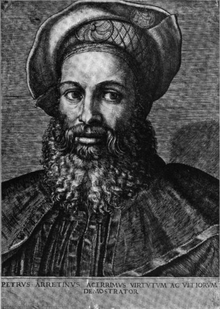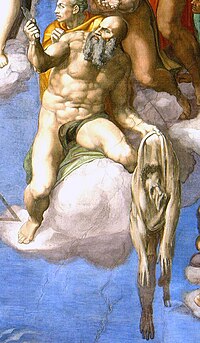Pietro Aretino
From Wikipedia, the free encyclopedia
| Pietro Aretino | |
|---|---|

Portrait of Pietro Aretino from the very rare line engraving of Marcantonio Raimondi
|
|
| Born | 20 April 1492 Arezzo |
| Died | 21 October 1556 (aged 64) Venice |
| Occupation | Author, playwright, poet, satirist |
| Nationality | Italian |

Pietro Aretino, in Titian's first portrait of him

St Bartholomew (Aretino was the model) displaying his flayed skin, in The Last Judgment by Michelangelo.

Der Tod des Dichters Pietro Aretino by Anselm Feuerbach.
Contents
Life
Born out of wedlock in Arezzo (Aretino, "from Arezzo"), very casually educated then banished from his native city, Aretino spent a formative decade in Perugia, before being sent, highly recommended, to Rome. There Agostino Chigi, the rich banker and patron of Raphael, took him under his wing.When Hanno the elephant, pet of Pope Leo X, died in 1516, Aretino penned a satirical pamphlet entitled "The Last Will and Testament of the Elephant Hanno." The fictitious will cleverly mocked the leading political and religious figures of Rome at the time, including Pope Leo X himself. The pamphlet was such a success that it started Aretino's career and established him as a famous satirist, ultimately known as "the Scourge of Princes."
Aretino prospered, living from hand to mouth as a hanger-on in the literate circle of his patron, sharpening his satirical talents on the gossip of politics and the Papal Curia, and turning the coarse Roman pasquinade into a rapier weapon of satire, until his sixteen ribald Sonetti Lussuriosi (Lust Sonnets) written to accompany Giulio Romano's exquisitely beautiful but utterly pornographic series of drawings engraved by Marcantonio Raimondi under the title I Modi finally caused such outrage that he had to temporarily flee Rome. In 2007, Michael Nyman set eight of the poems to music. They proved no less controversial: at a 2008 performance at Cadogan Hall, the programs were withdrawn on allegations of obscenity.[2]
After Leo's death in 1521, his patron was Cardinal Giulio de' Medici, whose competitors for the papal throne felt the sting of Aretino's scurrilous lash. The installation of the prudish Fleming Adrian VI ("la tedesca tigna" in Pietro's words) instead encouraged Aretino to seek new patrons away from Rome, mainly with Federico II Gonzaga in Mantua, and with the condottiero Giovanni de' Medici ("Giovanni delle Bande Nere"). The election of his old Medici patron as Pope Clement VII sent him briefly back to Rome, but death threats and an attempted assassination from one of the victims of his pen, Bishop Giovanni Giberti, in July 1525, set him wandering through northern Italy in the service of various noblemen, distinguished by his wit, audacity and brilliant and facile talents, until he settled permanently in 1527, in Venice, the anti-Papal city of Italy, "seat of all vices" Aretino noted with gusto.
He was a lover of both women and men; having declared himself a "sodomite" since birth. In a letter to Giovanni de' Medici written in 1524 Aretino enclosed a satirical poem saying that due to a sudden aberration he had "fallen in love with a female cook and temporarily switched from boys to girls..." (My Dear Boy). In his comedy 'Il marescalco', the lead man is overjoyed to discover that the woman he has been forced to marry is really a page boy in disguise. While at court in Mantua he developed a crush on a young man called Bianchino, and annoyed Duke Federico with a request to plead with the boy on the writer's behalf.[3]
From the security of Venice Aretino "kept all that was famous in Italy in a kind of state of siege," in Jakob Burckhardt's estimation. Francis I of France and Charles V pensioned him at the same time, each hoping for some damage to the other. "The rest of his relations with the great is mere beggary and vulgar extortion," according to Burckhardt.
- "His literary talent, his clear and sparkling style, his varied
observation of men and things, would have made him a considerable writer
under any circumstances, destitute as he was of the power of conceiving
a genuine work of art, such as a true dramatic comedy; and to the
coarsest as well as the most refined malice he added a grotesque wit so
brilliant that in some cases it does not fall short of that of
Rabelais."
- —Jacob Burckhardt, The Civilization of the Renaissance in Italy, 1855.
La cortigiana is a brilliant parody of Castiglione's Il Cortegiano, and features the adventures of a Sienese gentleman, Messer Maco, who travels to Rome to become a cardinal. He would also like to win himself a mistress, but when he falls in love with a girl he sees in a window, he realizes that only as a courtier would he be able to win her. In mockery of Castiglione's advice on how to become the perfect courtier, a charlatan proceeds to teach Messer Maco how to behave as a courtier: he must learn how to deceive and flatter, and sit hours in front of the mirror.
Aretino was a close friend of Titian, who painted his portrait (illustrations) at least three times. The early portrait is a psychological study of alarming modernity. Clement VII made Aretino a Knight of Rhodes, and Julius III named him a Knight of St. Peter, but the chain he wears for his 1545 portrait may have merely been jewelry. In his strictly-for-publication letters to patrons Aretino would often add a verbal portrait to Titian's painted one.
He is said to have died of suffocation from "laughing too much."[4]
Works
Poetry
- Sonetti lussuriosi
- Dubbi amorosi
- Orlandino
Prose
- Lettere
- Ragionamenti
Comedy
- Fraza
- La cortigiana
- Il marescalco
- La talanta
- Lo ipocrito
- Il filosofo
Tragedy
- Orazia
Notes
- Notably in The School of Whoredom, The Ragionamenti: The lives of nuns, the lives of married women, the lives of courtesans and his bawdy Dialoghi.
- "Classical Music News:: The Classical Source News:: Michael Nyman Festival Controversy :: Classical Music News". Classicalsource.com. 9 June 2008. Retrieved 26 December 2011.
- Sheila Hale, Titian: His life, HarperPress, 2012
- Waterfield, Gordon, ed. (1966). First Footsteps in East Africa. New York: Praeger Publishers. p. 59 footnote.
References
- Cleugh, James, 1965. The Divine Aretino Pietro of Arezzo, 1492–1556, A Biography
- Hutton, Edward, 1922. Pietro Aretino: The scourge of princes.
- Robert Greene, The 48 Laws of Power, Viking Penguin, 1998, ISBN 0-14-028019-7
- Norton, Rictor (ed.) My Dear Boy: Gay Love Letters through the Centuries. Leyland Publications, San Francisco. 1998
- Luba Freedman, Pietro Aretino, Titian's Portraits Through Aretino's Lens, Pennsylvania State University Press, 1995, ISBN 978-0-271-01339-8.
- Peter Brand, Charles Peter Brand, Lino Pertile, The Cambridge History of Italian Literature, Cambridge University Press, 1999, ISBN 978-0-521-66622-0.
- Elise Boillet, "L'Aretin et les papes de son temps," in Florence Alazard et Frank La Brasca (eds), La papauté à la Renaissance (Paris, Editions Honoré Champion, 2007) (Travaux du Centre d'Études Supérieures de la Renaissance de Tours, 12), 324–363.
Sources
External links
| Wikimedia Commons has media related to Pietro Aretino. |

No comments:
Post a Comment
Please leave a comment-- or suggestions, particularly of topics and places you'd like to see covered